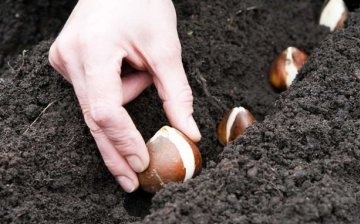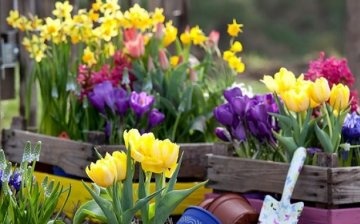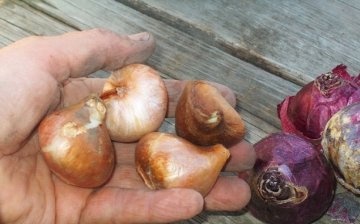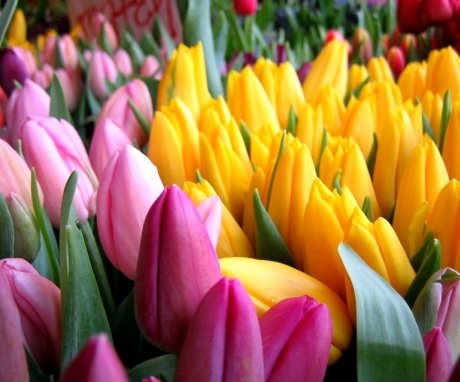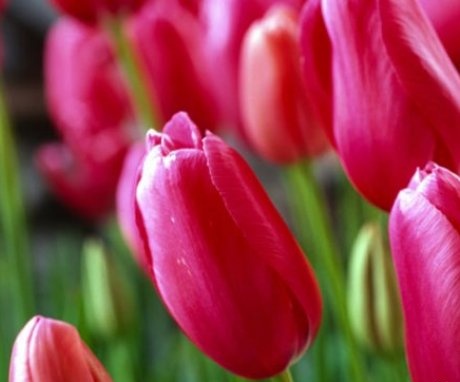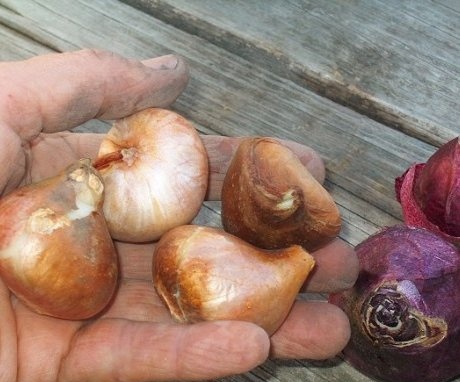Tulips - the best varieties, rules for planting and caring for flowers in the garden
Bright tulips have always been a delight for every gardener. They, like early birds, are the first to delight the owner of the site with their unsurpassed flowering. Tulips bloom in April or May, depending on the variety, and allow you to make May holidays light, filled with the spring scent of the first flowers. Flowers resemble bright and beautiful spots against the backdrop of greenery and other plants.
Their cultivation has already become a tradition in the culture of gardening, flower growers love to contemplate the noble varieties of tulips. A wide variety of colors and shapes make the flowers some of the most desirable on the site. Tulips are often used in landscape design; no flower bed design can do without their participation. For this simple reason, the florist should know the most popular and best plant varieties, the rules for growing, breeding and caring for their favorite tulips.
Content
- Tulips are the best varieties for the garden
- Growing conditions: temperature and lighting
- Recommendations for planting tulips
- Care after planting: watering and feeding
- Preparation for winter and storage conditions of bulbs
Tulips are the best varieties for the garden
There are over 140 plant species. It is customary to subdivide them depending on color, shape and period. flowering... A wide variety allows the grower to choose the best and most beautiful varieties. So, on the basis of color, variegated tulips and plants with a uniform color. Moreover, the homogeneous type also implies two-three-color buds. Variegated are distinguished by multi-colored blotches and "artist's strokes". For convenience, tulips are subdivided into classes - there are 15 of them, where from 1 to 11 are garden, and from 11 to 15 are cultural hybrids.
Classes are divided into two groups:
- The first begins to bloom from April (1-11)
- Second from March (11-15)
Among the many classes, the best are distinguished, meeting the wishes of gardeners and aesthetic requirements. There is the following classification:
- Early and late simple plants - this category includes tulipsblooming in April or May. The color ranges from bright red to yellow shades. The best varieties of this class are "Ibis Mon Tresor" and "Cooler Cardinal". Plants are not tall. Florists advise planting them in the foreground. flower bed... They bloom for quite a long time, up to 1.5 months.
- Early and late double - the class of plants is characterized by colors of bright red color and pale pink. The flowers are large, the plant blooms for a long time. The buds begin to open in April or May, depending on the variety. The stem height is small - up to 30 cm. The best varieties in this category are Murillo, Miranda and Electro.
- Group "Triumph" - tall plants with large flowers. The color ranges from red to white. Recently, varieties with a two-tone color have been bred. The most favorite and beautiful varieties are considered "Alba" and "Aviator Algiba". The first is distinguished by snow-white inflorescences, which look favorably against the background of scarlet roses and other bright colors. The variety is also called "northern snow". Plants in this category bloom at the end of April. They belong to the group of tulips with an average life. flowering.
- Group "Darwin" - rather tall plants, height up to 90 cm. The shape of the flower resembles a glass. Color from red to red-yellow. It begins to bloom in early May. The best varieties in this class are "Artist", "Parade", "Oxford" and "London". The first is bright red with yellow strokes. The rest of the varieties have a scarlet hue.
- Fringed is a very interesting class of plant. Flowers are distinguished by fringe along the edge of the petals. For example, the "Arma" variety has a dark red hue with delicate fringes around the edges. The variety looks very impressive against the background of white tulips. There are many varieties of this class. Their differences are only in color - a scarlet bud, but a silvery fringe and other combinations. This class is perfect for a growing method like distillation.
- Lily-colored - the class differs from others in the shape of the petals. They look like lily flowers, pointed tops. There are many shades from white to bicolor. Gardeners are very fond of the variety "Evening Song" or "Evening Dream". Flowers look great in the neighborhood with other bright varieties of tulips. They begin to bloom in May.
- Greens are very beautiful plants. The flowers have a green stripe against the background of the main color of the inflorescence. White flowers with a delicate green stripe look spectacular. Allocate the variety "Spring Green" or "Spring Green" with this color. They are often placed against a background of bright red tulips.
- The Rembrandt group is perhaps the most spectacular and unusual group of tulips. Their flowers have a unique color - multi-colored strokes are scattered against the background of the main shade. The class is not numerous, but there are queues for its varieties, since the flowers are very beautiful. Especially if tulips are grown for cut. It begins to bloom at the end of May. The Jack Line variety is very popular.
- Parrot species - the unusual shape of the flowers gave rise to the name of the class. The petals are similar to the tuft of parrots. The color can be different. Usually these are two-colored plants. They reach a height of 25 cm. Among the many varieties, one can distinguish "Comet". These are bright inflorescences that delight the eye of the grower and uplift.
Having decided on the ort, you can start preparing the soil for planting the bulbs. It is necessary to choose the optimal place for the tulips and inquire about the planting rules.
Growing conditions: temperature and lighting
Tulips love fertile soil with good drainage. In the wild, they can also be found on sandy soils. The acidity of the soil is neutral or slightly acidic. For cultivation experienced florists recommend choosing well-lit areas, but protected from the wind. Consider the type of plant. There are species with very fragile stems, and there are varieties with strong stems - they are not afraid of the wind or hurricane.
It is desirable that the place be protected from the northerly winds. Also consider the method of growing when choosing a site - whether you will dig them out every year or not. There is a small nuance when planting tulips - the old crops should not be tomatoes or potatoes... Flowers are very susceptible to nightshade diseases.
The temperature for planting bulbs should vary from 9 ° to 12 ° - this is the average temperature in September, when tulips are planted.
The same temperature indicators should be adhered to when planting bulbs in room conditions, if the goal of distilling flowers by March is pursued. They begin to prepare the soil two to three weeks before planting the bulbs in the ground. There are several ways to plant tulips. They will depend on the purpose for which the tulips are grown.
Recommendations for planting tulips
For those who just want to admire the flowers in the garden in spring, the classic way of planting a plant is suitable:
- The bulbs are planted in September, not in the spring, as is the case with other flower crops.
- Prepare the soil 2-3 weeks before landing... The process is reduced to digging the selected area and making fertilizers - rotted humus or compost, complex fertilizers containing compounds such as superphosphate, potassium salt and nitrogen. Agricola can be used. However, many growers limit themselves to humus (but not fresh manure!) And compost.
- The soil is carefully dug up and covered with a film.
- During the preparation of the soil, it is necessary to monitor the appearance weeds, they shouldn't be.
- When the planting date comes up - September - the planting of the bulbs begins. For this, shallow holes are made and spilled with settled rainwater.
- The bulbs are carefully placed in the holes and covered with earth, tamping, but leaving the middle of the hole. The bulb is deepened by about 10-12 cm. Focus on the size of the bulb. Planting depth is about three sizes of the bulb.
- Cover the holes with mowed grass closer to November. Mulch will prevent the ground from freezing.
The second planting method will allow the grower to bloom in March. It is usually used by those who grow tulips for sale. Flowers are driven out by March 8. To do this, choose a cool place in the room. Prepare the soil and plant the bulbs. The main thing here is to provide good drainage in a container or flowerpot and choose a room with a low temperature. Without these conditions to grow tulips by March will not work. After holding the planted bulbs in the dark and cold, they are taken out into an already warm room. In this way, the change of seasons is emitted and the plant begins to grow as if spring had come. This method will allow the grower to grow flowers quickly.
If you don't feel like digging up tulips every year, you can leave the plant for the winter without digging it up.
To do this, remove all yellowed leaves and stems. The ground looses and remains calm until November. Watering the plot is terminated. The soil and bulbs should rest. Then, in October or early November, the site is covered with mulch from sawdust or peat. Many people use cut grass. Place the layer no more than 6 cm high. Before doing this, spill the flowerbed with settled rainwater. So a tulip can grow in one place for 4 years. But then you have to dig them out anyway and plant new bulbs.
No matter the way cultivation always observe the main condition - the bulbs must first be kept in cold and dark, and then exhibited in a warm room. Create natural growth conditions for them.
Care after planting: watering and feeding
Tulips love moist soil. It is necessary to monitor soil moisture from the moment young shoots appear. It is not recommended to overflow the plant, otherwise the bulbs will begin to rot. Tulips are considered unpretentious plants. This is true, but it is necessary to monitor watering and weed.
The plant is fed three times during the entire growing season:
- The first introduction of a complex fertilizers produced after the first shoots.
- The second is done before flowering.
- Third - at the end of flowering.
It is recommended to choose complexes with phosphorus and potassium compounds. Be careful with nitrogen, do not apply this fertilizer at the end of the flowering plant.
If flowers are cut, use a disinfected tool. Otherwise, you can bring the fungus into the root system of the plant. As soon as the tulip has faded, the stems and leaves have turned yellow, you can safely begin to dig up the bulbs and prepare them for landing... To do this, they are dried, sorted and sent to a dark, dry and cool place.
During the growth period, the soil should be loosened in a timely manner.
From fairly frequent watering, the soil is compressed, air does not penetrate to root system... This can cause the bulb to rot. Timely aeration can help keep you out of trouble. The decayed bulb can no longer be saved.
Preparation for winter and storage conditions of bulbs
Before the onset of frost, experienced flower growers cover the area with tulips with mulch with a layer of up to 6 cm. It can be made from sawdust, peat or cut grass. So the soil will freeze and retain moisture. But do not forget to stir up the mulch in the spring so that the air begins to penetrate into the soil. In northern latitudes, a flowerbed with bulbs is covered with denser materials - non-woven fabric plus sawdust mulch.
Before planting, the bulbs are soaked in a weak solution of manganese for disinfection purposes or fungicide.
They need to be sorted - rotten or affected bulbs are discarded. Only healthy bulbs are used for planting. Next, the material should be dried and then removed to a dark, cool place. Some gardeners store bulbs in refrigerators in vegetable drawers. So the bulbs are stored until they are planted in open ground in September.
All of these rules apply to those gardeners who decide to dig up the bulbs every year. Do not forget that you do not need to dig up tulips. They can grow in one place for up to 4 years. However, flowering will become smaller every year, the size of flowers will be smaller and smaller. Therefore, it is better to dig them up and plant them in a new place every time.
Compliance with simple rules cultivation, dilution and leaving will help the gardener grow a luxurious flower bed tulips... You can cultivate the plant along with other flowers - pansies, roses and other plants. The recommendations of experienced florists will allow you to competently breed some of the most beautiful and beloved flowers. Try to choose varieties and classes of plants according to the characteristics of the growing region. However, flower growers primarily rely on the aesthetic qualities of the plant. Fortunately, there is a great variety of them and there is plenty to choose from.
More information can be found in the video.






